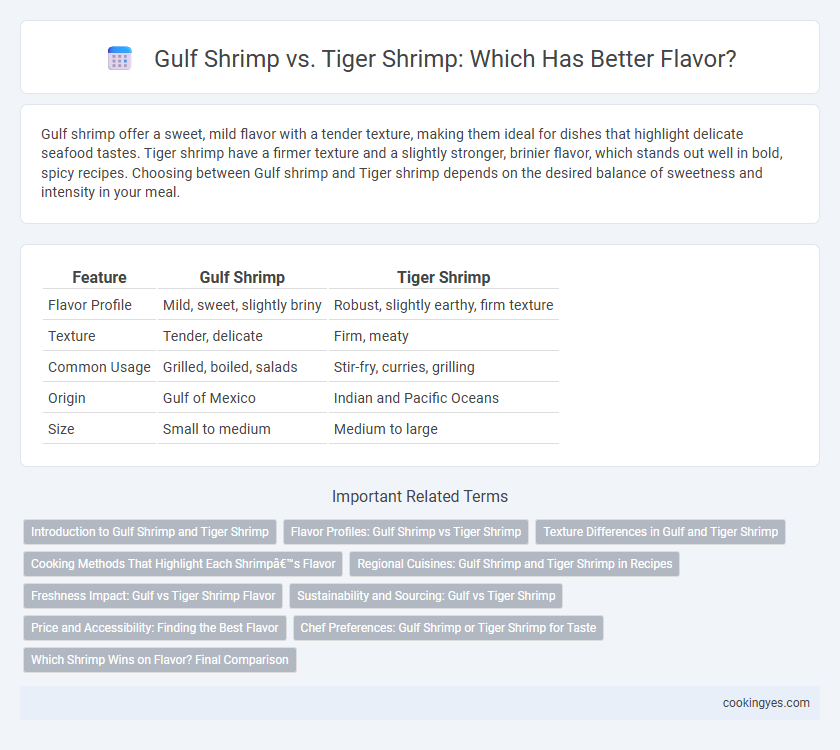Gulf shrimp offer a sweet, mild flavor with a tender texture, making them ideal for dishes that highlight delicate seafood tastes. Tiger shrimp have a firmer texture and a slightly stronger, brinier flavor, which stands out well in bold, spicy recipes. Choosing between Gulf shrimp and Tiger shrimp depends on the desired balance of sweetness and intensity in your meal.
Table of Comparison
| Feature | Gulf Shrimp | Tiger Shrimp |
|---|---|---|
| Flavor Profile | Mild, sweet, slightly briny | Robust, slightly earthy, firm texture |
| Texture | Tender, delicate | Firm, meaty |
| Common Usage | Grilled, boiled, salads | Stir-fry, curries, grilling |
| Origin | Gulf of Mexico | Indian and Pacific Oceans |
| Size | Small to medium | Medium to large |
Introduction to Gulf Shrimp and Tiger Shrimp
Gulf shrimp, primarily found in the warm waters of the Gulf of Mexico, are renowned for their sweet, tender flavor and firm texture, making them a favorite for dishes requiring delicate seafood. Tiger shrimp, native to the Indo-Pacific region, offer a robust, slightly briny taste with a succulent, meaty bite, distinguished by their characteristic dark stripes and larger size. Both varieties provide versatile culinary options, with Gulf shrimp excelling in light preparations and Tiger shrimp standing out in bold, flavorful recipes.
Flavor Profiles: Gulf Shrimp vs Tiger Shrimp
Gulf shrimp offer a sweet, mild flavor with a firm, tender texture, making them ideal for dishes that highlight delicate seafood tastes. Tiger shrimp feature a bold, slightly briny flavor with a firmer, meatier texture, often preferred in robust, spiced recipes. The distinct flavor profiles of Gulf and Tiger shrimp influence their culinary uses, with Gulf shrimp suiting subtle seasonings and Tiger shrimp complementing stronger, savory spices.
Texture Differences in Gulf and Tiger Shrimp
Gulf shrimp offer a firm, slightly crisp texture that enhances their sweet, mild flavor, making them ideal for grilling or sauteing. Tiger shrimp, known for their larger size, have a meatier and firmer bite with a slightly chewier consistency, providing a robust texture that holds up well in hearty dishes. Texture differences between Gulf and Tiger shrimp significantly influence their culinary applications and flavor perception.
Cooking Methods That Highlight Each Shrimp’s Flavor
Grilling Gulf shrimp over high heat enhances its naturally sweet and briny flavor, making it ideal for simple seasoning with garlic and lemon. Tiger shrimp's robust and meaty texture stands out when sauteed with bold spices or incorporated into rich, creamy sauces. Both types benefit from quick cooking methods to preserve their distinct flavors and tender bites.
Regional Cuisines: Gulf Shrimp and Tiger Shrimp in Recipes
Gulf shrimp, prized for their sweet, tender meat, are central to Southern U.S. dishes like shrimp and grits and gumbo, highlighting the flavors of the Gulf Coast. Tiger shrimp, known for their firm texture and robust taste, are popular in Southeast Asian recipes such as Thai curry and Malaysian satays, where bold spices complement their natural flavor. Regional cuisines leverage these distinct shrimp varieties to create signature dishes that celebrate local ingredients and culinary traditions.
Freshness Impact: Gulf vs Tiger Shrimp Flavor
Gulf shrimp tend to have a sweeter, more delicate flavor compared to the robust, slightly brinier taste of tiger shrimp. Freshness significantly impacts the flavor profile, with Gulf shrimp maintaining a tender texture and natural sweetness when fresh, whereas tiger shrimp's firm flesh and bold flavor can become noticeably diminished if not consumed promptly. The optimal flavor experience depends on immediate freshness, making Gulf shrimp preferable for subtle, sweet dishes and tiger shrimp ideal for recipes requiring a pronounced shrimp taste.
Sustainability and Sourcing: Gulf vs Tiger Shrimp
Gulf shrimp, predominantly wild-caught in the Gulf of Mexico, offer superior sustainability due to strict federal regulations and bycatch reduction programs, minimizing environmental impact. Tiger shrimp, often farmed in Southeast Asia, raise sustainability concerns related to habitat destruction, chemical usage, and water pollution in aquaculture practices. Choosing Gulf shrimp supports more responsible sourcing with traceable supply chains, whereas tiger shrimp sourcing requires careful evaluation of farm certification standards to ensure eco-friendly production.
Price and Accessibility: Finding the Best Flavor
Gulf shrimp tend to be more affordable and widely available, offering a mild, slightly sweet flavor that complements a variety of dishes. Tiger shrimp generally command higher prices due to their larger size and firmer texture, appealing to those seeking a more robust, briny taste. Price and accessibility often influence the choice between Gulf and Tiger shrimp, with budget-friendly Gulf shrimp being easier to source from U.S. Gulf Coast markets.
Chef Preferences: Gulf Shrimp or Tiger Shrimp for Taste
Chefs often prefer Gulf shrimp for its sweeter, more delicate flavor and tender texture, which enhances subtle seafood dishes. Tiger shrimp deliver a firmer bite and a stronger, brinier taste that stands out in robust recipes. Flavor profiles and culinary applications guide professional chefs in choosing Gulf shrimp for elegance and Tiger shrimp for boldness.
Which Shrimp Wins on Flavor? Final Comparison
Gulf shrimp delivers a sweet, mild flavor with a tender yet firm texture, making it a favorite in Southern coastal cuisine, while tiger shrimp offers a meatier bite and a slightly briny taste, preferred in Southeast Asian dishes. Flavor intensity varies with harvesting conditions, but Gulf shrimp's natural sweetness often wins for those seeking a delicate, buttery profile. For bold, robust flavor lovers, tiger shrimp's pronounced taste and firm texture provide a winning experience.
Gulf shrimp vs Tiger shrimp for flavor Infographic

 cookingyes.com
cookingyes.com